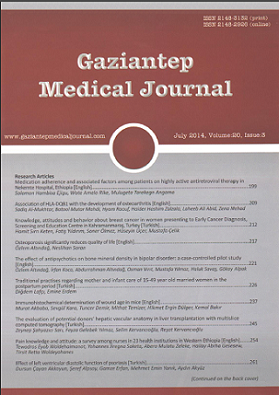A rare case of infective endocarditis caused by Candida albicans
Candida albicans’ın etken olduğu nadir bir infektif endokardit olgusu
DOI:
https://doi.org/10.5455/GMJ-30-157110Keywords:
Candida, infective endocarditis, neonateAbstract
Despite significant advances in medical, surgical, and critical care interventions, infective endocarditis (IE) remains a disease associated with considerable morbidity and mortality. Fungal endocarditis is relatively unusual in children although it is one of the most feared forms of endocarditis. Candida species are the most common organisms recovered. In neonates, this infection may be a complication of intensive care measures, including hyperalimentation fluid infusion, use of broad-spectrum antibiotics for a prolonged time, and extended use of indwelling venous catheters. The mortality rate from fungal endocarditis is high, even with intensive medical and surgical therapy. The present paper aimed to present a third-month-old girl baby with candida infective endocarditis (fungus ball) diagnosed and surgically operated.
Metrics
References
Pierrotti LC, Baddour LM. Fungal endocarditis, 1995-2000. Chest 2002;122(1):302-10.
Tissières P, Jaeggi ET, Beghetti M, Gervaix A. Increase of fungal endocarditis in children. Infection 2005;33(4):267- 72.
Muehrcke DD. Fungal prosthetic valve endocarditis. Semin Thorac Cardiovasc Surg 1995;7(1):20-4.
Muehrcke DD, Lytle BW, Cosgrove DM. Surgical and longterm antifungal therapy for fungal prosthetic valve endocarditis. Ann Thorac Surg 1995;60(3):538-43.
Hogevik H, Alestig K. Fungal endocarditis-a report on seven cases and a brief review. Infection 1996;24(1):17-21.
Russell HM, Johnson SL, Wurlitzer KC, Backer CL. Outcomes of surgical therapy for infective endocarditis in a pediatric population: a 21-year review. Ann Thorac Surg 2013;96(1):171-4.
İrdem A, Başpınar O, Kervancıoğlu M, Kılınç M, Şahin DA. infektif endokarditli olguların retrospektif olarak değerlendirilmesi. J Pediatr Inf 2012;6(4):127-132.
Rubinstein E, Noriega ER, Simberkoff MS, Holzman R, Rahal JJ Jr. Fungal endocarditis: analysis of 24 cases and review of the literature. Medicine (Baltimore) 1975;54(4):331-4.
Horstkotte D, Follath F, Gutschik E, Lengyel M, Oto A, Pavie A, et al. Guidelines on prevention, diagnosis and treatment of infective endocarditis executive summary; the task force on infective endocarditis of the European Society of Cardiology. Eur Heart J 2004;25(3):267-76.
Baddour LM, Wilson WR, Bayer AS, Fowler VG Jr, Bolger AF, Levison ME, et al. Infective endocarditis: diagnosis, antimicrobial therapy, and management of complications: a statement for healthcare professionals from the Committee on Rheumatic Fever, Endocarditis, and Kawasaki Disease, Council on Cardiovascular Disease in the Young, and the Councils on Clinical Cardiology, Stroke, and Cardiovascular Surgery and Anesthesia, American Heart Association: endorsed by the Infectious Diseases Society of America. Circulation 2005;111(23):e394-434.
Chirillo F, Scotton P, Rocco F, Rigoli R, Pedrocco A, Martire P, et al. Management strategies and outcome for prosthetic valve endocarditis. Am J Cardiol 2013;112(8):1177-81.
Millar BC, Jugo J, Moore JE. Fungal endocarditis in neonates and children. Pediatr Cardiol 2005;26(5):517-36.
Talarmin JP, Boutoille D, Tattevin P, Abgueguen P, Ansart S, Roblot S, et al. Candida endocarditis: role of new antifungal agents. Mycoses 2009;52(1):60-6.
Downloads
Published
How to Cite
Issue
Section
License
Copyright (c) 2023 European Journal of Therapeutics

This work is licensed under a Creative Commons Attribution-NonCommercial 4.0 International License.
The content of this journal is licensed under a Creative Commons Attribution-NonCommercial 4.0 International License.


















